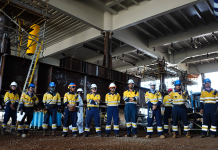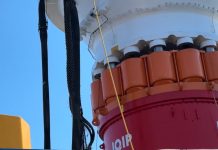A concrete replacement floating foundation developed for deep-water wind farms far off the coast could last up to 100 years. Designed for durability and scalability, it would be capable of supporting up to three consecutive generations of wind-turbine generators of 7 MW or higher.
The expansion of offshore wind-turbine power generation is inevitable and growing due to the ready supply of high quality wind energy, and the elimination of many of the restrictions of generation on land. To date, one of the major hurdles has been the development of reliable floating foundations with a long service life and that can be easily installed in deep water.
 Current concrete technology is not robust enough for the long-term exposure experienced in an ocean wind farm, and steel technologies require complicated shoreside construction and at-sea installation procedures with multiple large crane barges. The Marine Advanced Composite Concrete (MACC™) material and newly developed assembly/erection ocean-going deck barge (OGDB) has solved both of these issues. The breakthroughs to achieve this are three-fold:
Current concrete technology is not robust enough for the long-term exposure experienced in an ocean wind farm, and steel technologies require complicated shoreside construction and at-sea installation procedures with multiple large crane barges. The Marine Advanced Composite Concrete (MACC™) material and newly developed assembly/erection ocean-going deck barge (OGDB) has solved both of these issues. The breakthroughs to achieve this are three-fold:
The first is changing the ordinary Portland cement (OPC) binder in the concrete. The second is replacing the coated steel rebar with a material that will achieve a non-metallic reinforcing structural frame. The third is forming, ballasting, and launching the foundation’s floating spar, and then installing the wind-turbine generator (WTG), in a completely novel way. The combination of these advances will increase the longevity of the system while simultaneously reducing construction, installation, and maintenance costs.
Deep Offshore Advantages
The beauty of deep offshore wind is that it does not consume real estate or block views while using a steadier and more predictable wind. This condition allows for the use of larger turbines. A new spar buoy foundation system with its new construction and deployment processes will enable erection for a fraction of the current foundation cost for deep-water wind farms. This concept will have a lower installation cost due to the way it is produced and deployed. The floating displacement substructure and WTG topside are constructed and assembled in parallel on an OGDB while tied to the quay, which is then released and towed to the wind farm for final assembly and deployment.
The Marine Advanced Composite Concrete (MACC) and cost opinion are based on a 100-unit floating offshore wind system (FOWS). Each FOWS unit will consist of a floating substructure (spar buoy) and a large offshore WTG. The units are stationed approximately 1,000 meters (3,300 feet) apart to minimize the wind-shadow effect. Each 6 MW WTG stands 656 feet above the mean sea level. The FOWS will maintain station-keeping via six synthetic ropes tethered to three anchors on the ocean floor.
Material Improvements
The revolution in materials is the basis of this new technology. In existing marine concrete structures, the greatest threat is water, either fresh or salt. Through time, water penetrates into concrete through unseen cracks and the natural porosity and rusts the rebar skeleton. Even protected rebar has coating failures and deterioration that eventually allows the steel failure.
Seawater also directly attacks the chemistry of OPC, causing rapid failure. What causes the OPC binder to fail at sea is the high percentage of calcium compounds (approximately 70 percent) that come under attack by the sulphur compounds in seawater. This rots the concrete. The binder, in a concrete mix design, can occupy up to 20 percent of the mass of the concrete. Replacing the OPC in the concrete mix design with a geopolymer binder will foil this degradation scenario by minimizing the calcium compounds in its chemical composition.
The geopolymer cement binder is made up of four inexpensive and widely available components: type-F fly ash, fresh water, waterglass (sodium-silicate), and lye (sodium hydroxide). With the type-F low calcium fly ash, the binder can have as little as 2 percent calcium, producing a saltwater-resistant material. Geopolymer cement binders are used commercially elsewhere in the world due to their superior performance to OPC binders. In general, these cements are stronger and both fireproof and waterproof. They bond well to most materials, have minimal expansion or contraction, are formable, and are resistant to salts, acids, and alkalis. The production process for geopolymers has an approximately 80 percent smaller carbon footprint than standard OPC.
To replace the steel rebar, a nonmetallic bar made from readily available basalt is used for reinforcement. Basalt stone is found all over the Earth and is a key component enabling the hundred-year durability of the substructure. The basalt stone, when heated to a temperature of 1,800 degrees, turns to a liquid that is run through a palladium die that produces soft flexible threads.
The threads are laid in parallel and locked together with an epoxy, producing basalt rebar: a water-proof, chemical-resistant, fireproof material with a tensile strength several times stronger than steel. The geopolymer binder in the concrete binds to the basalt rebar on a chemical level in addition to the mechanical bond. The basalt bar is extremely light and also fairly flexible, lending to easy placement in the structure. Cut basalt fiber additives, much like nylon fibers, also are used in the mix design for added strength. The substructure will have a minimum of a 100-year life due to the low porosity, high-strength, and heat-cured technology found in the geopolymer binder in the concrete mix design.
 Forming the Foundation Substructure
Forming the Foundation Substructure
The selection of the type of floating foundation substructure was based on a survey of wind-farm developers. Their choice, to meet the rigors of offshore deep-water wind-turbine operating requirements, is the spar buoy based on more than two years of full-scale testing. The current construction and deployment of a spar buoy (approximately 400 feet long) consists of a steel fabrication plant, horizontal move out, and horizontal launch into the harbor water, tow out to 100-meter water for rotation to vertical, tow out of the ballast placement barge for fixed ballast placement, mating of the substructure to the topside structure, and final tow out to the wind-farm site. All of these operations have long open-water residence time and are significantly affected by ambient sea states.
But there is an alternative to this construction and deployment that will substantially reduce “port-to-site” cost and time. To develop a new construction method of building a concrete spar buoy, a wide variety of formwork systems used around the world were studied, including pre-cast/post-tensioned incremented structures for their simplicity. All but one were dismissed as unable to improve overall port-to-site time and cost. The only method to show significant promise in reducing timelines and cost was slip forming.
The major problem encountered was forming a large round structure with internal struts tied to a second internal round, made particularly difficult with struts in a perpendicular mode for rebar and concrete placement. Additionally, placement of the final structure in the water horizontally calls for further structural requirements built in to the design. The best production time frame, of all the formwork systems, was 41 days. Slip forming produced the most cost effective solution with a heat-cured formwork that can achieve a 2-foot-an-hour slip to complete spar formation in only seven days, at a saving of 500 crew hours.
Slipping the spar uses all of the standard methodology except for the heated formwork and the tremie trunk placement of the geopolymer concrete. (The mix design cannot be pumped due to the friction heat generation.)
The spar buoy, slip formed as a seamless concrete displacement structure, will have its steel jack rods extracted at the end of the slip, producing a concrete structure with no steel in its make-up.
Ocean-Going Deck Barge
The cost to slip on land and achieve a lay down of the structure becomes uneconomical due to the weight of the spar and the cost of the ballast placement operation at sea. Therefore, the ocean-going deck barge (OGDB) concept was developed as a solution. To simplify the overall process, the OGDB serves as a construction platform, transportation, and erection platform, all in one. With the barge moored to the quay with ready access to materials and resources, the spar is slipformed at one end while simultaneously the WTG is assembled at the other.
When substructure construction and topside assembly are complete, the barge is towed out to the wind-farm site with both components onboard. At the site, the spar is deployed into the water, water-ballasted down, and moored into location with traditional mooring methods. The barge is rotated to position the WTG over the spar, which is then de-ballasted, joined, and mechanically locked to the WTG topside.
The barge overall dimensions are 440 feet long by 148 feet beam by 27 feet deep. This, less deck well cuts fore and aft, results in 60,120 square feet of deck area. The weight of the barge per square foot, including the extra hard point structural framing, ballast system pumps, and piping is estimated at 600 lbs/ft2, for a total of 18,036 short tons. With a foot of draft displacing 1,924 short tons, the unloaded barge will have a draft of 9.4 feet. The estimated deck load (with no spar or WTG loads) adds 3,700 short tons. Prior to the spar production and WTG assembly, the ballast tanks will be filled with 12,084 short tons of water at the quay, bringing the total to 17.6 feet of draft. The total weight before production at the quay is 33,800 short tons.
During the 12-day slip and WTG assembly, the ballast management system will pump out the 12,084 short tons of ballast to maintain a steady draft and level deck surface as construction and assembly materials are loaded and positioned on the barge. At tow-out, with the spar construction and the WTG assembly complete, the OGDB draft will remain 17.6 feet, with a tow-out freeboard of 9.4 feet.
There are two towers on the OGDB. The first is for the spar buoy. This multi-functional structural tower is made up of high-strength man lift mast sections. The port side, forward leg of this tower supports a rack-and-pinion man lift. All four legs of this tower support two lift-up gripper-retention systems. These gripper rings are raised up and engaged after the slip formwork stage has passed the half and three-quarter points on the finished spar buoy. Integral with the tower is a lowering and receiving structure (LRS). The LRS frame is designed to support the end bell (constructed ashore, and shown in graphic on page 47) for the spar buoy, its weight, the spar buoy’s weight, and the stone ballast. The LRS is held in the tower over the aft well of the OGDB by eight Dyneema tendons (designed for salt-water immersion). At the other end of the barge is the tower supporting the WTG as it is assembled.
 On-Barge Construction
On-Barge Construction
The construction is supported and executed on the OGDB at the quay. The first component (built on the land side) is the end-bell starter section. It is 40 feet in diameter by 30 feet high and is lifted down and set into the LRS well, with an indexing pin into the center of the bottom of the end bell. Fine sand is placed in order to stabilize the set between the concrete end bell and the galvanized steel LRS. The next operation is placing stone ballast in the first 20 feet for added stability.
Next, the slip formwork and formwork staging is placed in four pie-shaped quadrants onto the end-bell starter. The spar is slip-formed another 70 feet and then paused to place the remaining permanent ballast stone. The slip is then continued to the 330-feet level where the formwork is removed from the outer hull, allowing the stem framing to be released from the final stage for continued slipforming of the last 60 feet of the stem. Simultaneously with the spar slip-forming, the WTG is assembled at the other end of the barge. The WTG support structure, built around and cantilevered out over the bow well, is designed to support the transition component with its lock and release system for mating to the substructure. The WTG will be assembled atop this transition component, again with close attention to the water-ballast management.
Once the construction is completed on the barge, it is towed out of the harbor to the installation location. With the high windage of the spar buoy, WTG, and associated towers, weather will be watched carefully to ensure conditions are right for a safe transit.
Dynamic Positioning
Critical to a safe and efficient operation, the OGDB is equipped with eight thrusters controlled by a dynamic positioning system to quickly position and hold the OGDB as the components are deployed. The dynamic positioning will have active wind and current compensation, thruster selection and enabling, power management, automatic heading hold, and other pertinent sensors. All of the information sensors, data readout, video feeds, and manual and joystick controls for the entire OGDB will be housed and displayed on the control console in the third level of the superstructure.
Deploying the Spar Buoy
Upon arrival at the installation site, the spar buoy is deployed into the water. The total weight of the spar buoy, stone ballast, and LRS will require eight linear winches to lower it into the water. Each linear jack is rated at 1,405 short tons with a 2.5 minimum safety factor. All are operated simultaneously from a single computer platform.
All are attached to Dyneema tendons that have a proven long life in salt water; they in turn are attached to steel jacking strands that do not enter the water. There are 84 steel jacking strands in a bundle weighing in at 100 lbs/foot going through the jack. To keep the bundle tensioned, a synthetic rope is attached to a 25-ton counter weight and then to a lifting winch. During the spar buoy lowering operation, the water ballast management system again controls the deck leveling system, in direct reverse to the construction and assembly phase.
After a small lift to release the LRS’ hold and lock system, the Dyneema tendons lower the LRS, with the spar buoy, into the water. Upon reaching a free-floating condition, and then ballasting to a designated level, the station-keeping crew will tether it to the ocean bottom anchors.
WTG Placement and Support
The OGDB dynamic positioning system is then used to position the WTG topside over the substructure for an accurate lift-up and locking of the substructure into the WTG transition assembly. The bow well, under the top support structure, is designed to receive the outer hull of the spar buoy. The substructure is then slowly de-ballasted to lift it up and insert the stem on top of the spar into the transition section. This component is equipped with a lock-and-hold system for securing the substructure to the topside.
This assembly method eliminates the need for expensive heavy marine cranes, minimizes open water residence time, and provides a means of changing out the turbine at a later date or for returning the WTG to the quay for repairs. Turbine replacement is required every 25 to 30 years, according to the University of Maine. This reuse of the foundation, up to four times minimum, becomes extremely cost effective. The reinstallation of the turbine, by design, has been made completely reversible without affecting the station keeping of the spar buoy substructure.
Construction Cost Opinion
This opinion, with accurate input, identifies the unit cost at $6.9 million per turbine spar (excluding the cost of the WTG itself) for assembly and delivery to a station-keeping crew in the 100-unit FOWS. This installation cost is a fraction of the current floating foundation cost and includes the following: MACC construction, in-harbor construction and assembly without intermediate transfer to a barge, self-deployment, and WTG assembly.
Summation
The MACC spar buoy and associated ocean-going deck barge are revolutionary approaches to greatly reduce offshore WTG capital and O&M cost. From the new material selection, which enables novel fabrication techniques in the offshore industry, to the unique barge enabling simplified transportation and WTG deployment logistics, these advances challenge the status quo in offshore wind-farm development.
Additionally, the geopolymer concrete cement binder supports aggressive global carbon reduction goals by producing 80 percent less CO2 and in a much shorter fabrication process. It is stronger and has a longer service life in saltwater, which extends the life span and reduces overall costs.



























